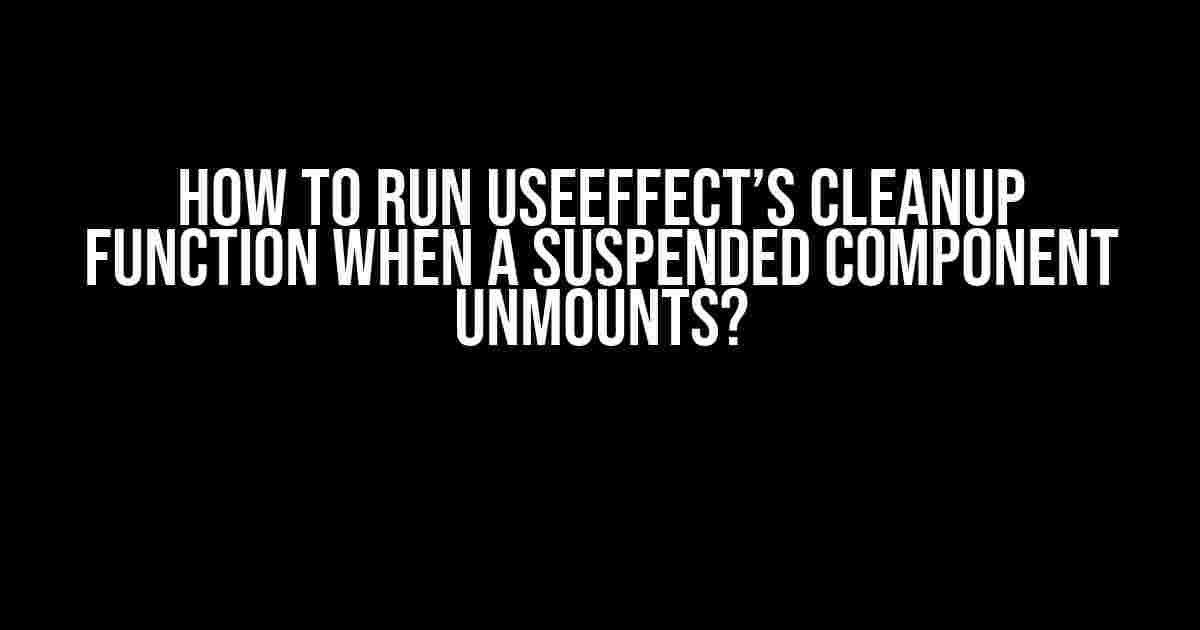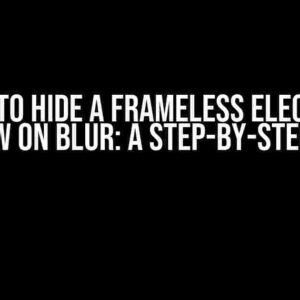Are you tired of struggling with useEffect’s cleanup function not being triggered when a suspended component unmounts? You’re not alone! This is a common issue many React developers face, and it’s a crucial one to resolve. In this article, we’ll delve into the world of useEffect and provide a step-by-step guide on how to ensure your cleanup function is executed when a suspended component is unmounted.
Why Does This Problem Occur?
Before we dive into the solution, let’s first understand why this problem occurs. When a component is suspended, it’s not completely unmounted from the DOM. Instead, it’s paused, and React retains its state. This is a performance optimization technique used by React to conserve resources. However, this also means that the useEffect hook’s cleanup function is not triggered when the component is suspended.
The useEffect Hook’s Cleanup Function
The useEffect hook is a powerful tool in React that allows you to perform side-effects, such as making API calls or setting timers, after rendering a component. It takes two arguments: a function to execute after rendering, and an optional dependency array. When the dependencies change or the component is unmounted, the useEffect hook’s cleanup function is triggered.
import { useEffect, useState } from 'react';
function MyComponent() {
const [count, setCount] = useState(0);
useEffect(() => {
// Effect function
console.log('mounted');
return () => {
// Cleanup function
console.log('unmounted');
};
}, [count]);
return (
Count: {count}
);
}In the above example, the useEffect hook’s cleanup function is triggered when the component is unmounted or the count state changes.
The Solution: Using the `useLayoutEffect` Hook
One way to ensure the useEffect hook’s cleanup function is triggered when a suspended component unmounts is to use the `useLayoutEffect` hook instead. The `useLayoutEffect` hook is similar to the `useEffect` hook, but it fires after all DOM mutations, making it a better choice for handling cleanup functions.
import { useLayoutEffect, useState } from 'react';
function MyComponent() {
const [count, setCount] = useState(0);
useLayoutEffect(() => {
// Effect function
console.log('mounted');
return () => {
// Cleanup function
console.log('unmounted');
};
}, [count]);
return (
Count: {count}
);
}In this example, we’ve replaced the `useEffect` hook with the `useLayoutEffect` hook. This ensures that the cleanup function is triggered when the suspended component is unmounted.
Another Solution: Using a Ref to Store the Cleanup Function
Another approach is to store the cleanup function in a ref using the `useRef` hook. This way, you can manually call the cleanup function when the suspended component is unmounted.
import { useState, useRef, useEffect } from 'react';
function MyComponent() {
const [count, setCount] = useState(0);
const cleanupRef = useRef(null);
useEffect(() => {
// Effect function
console.log('mounted');
return () => {
// Store the cleanup function in the ref
cleanupRef.current = () => {
console.log('unmounted');
};
};
}, [count]);
// Manually call the cleanup function when the component is unmounted
useEffect(() => {
return () => {
if (cleanupRef.current) {
cleanupRef.current();
}
};
}, []);
return (
Count: {count}
);
}In this example, we store the cleanup function in a ref using the `useRef` hook. We then manually call the cleanup function when the suspended component is unmounted using another `useEffect` hook.
Best Practices for Handling Suspended Components
When working with suspended components, it’s essential to follow best practices to ensure your application behaves as expected. Here are some tips to keep in mind:
- Use `useLayoutEffect` instead of `useEffect`: As we’ve seen, `useLayoutEffect` is a better choice for handling cleanup functions when a suspended component unmounts.
- Store the cleanup function in a ref: Storing the cleanup function in a ref allows you to manually call it when the suspended component is unmounted.
- Use a single `useEffect` hook for cleanup: Avoid using multiple `useEffect` hooks for cleanup, as this can lead to unexpected behavior. Instead, use a single `useEffect` hook and store the cleanup function in a ref.
- Test your application thoroughly: Suspended components can behave differently depending on the browser and environment. Make sure to test your application thoroughly to ensure it works as expected.
Conclusion
In conclusion, handling suspended components in React requires careful consideration and attention to detail. By using the `useLayoutEffect` hook or storing the cleanup function in a ref, you can ensure that your cleanup function is triggered when a suspended component unmounts. Remember to follow best practices and test your application thoroughly to avoid any unexpected behavior.
| Solution | Description |
|---|---|
| Use `useLayoutEffect` instead of `useEffect` | Ensures the cleanup function is triggered when a suspended component unmounts |
| Store the cleanup function in a ref | Allows manual calling of the cleanup function when the component is unmounted |
By following the instructions and tips outlined in this article, you’ll be well-equipped to handle suspended components in your React application and ensure your cleanup functions are executed as expected.
Final Thoughts
React’s suspension mechanism is a powerful tool for improving performance, but it requires careful handling to avoid unexpected behavior. By understanding the intricacies of useEffect’s cleanup function and following best practices, you can create fast and efficient React applications that delight your users.
Do you have any questions or concerns about handling suspended components in React? Share them in the comments below, and we’ll be happy to help!
Additional Resources
- React Documentation: useEffect Hook
- React Documentation: useLayoutEffect Hook
- MDN Web Docs: Document Object Model
Thanks for reading, and happy coding!
Frequently Asked Question
Get the lowdown on how to trigger useEffect’s cleanup function when a suspended component unmounts!
Question 1: Why does useEffect’s cleanup function not run when a suspended component unmounts?
When a component is suspended, React doesn’t consider it unmounted, so the cleanup function isn’t triggered. This is because the component is still in memory, and React is just temporarily pausing its rendering. To get around this, you need to use a combination of useEffect and useState to manually trigger the cleanup function.
Question 2: How do I use useState to trigger the cleanup function?
Create a state variable that tracks whether the component is mounted or not. When the component unmounts, update the state variable, and use useEffect to watch for changes to this state. When the state changes, call the cleanup function. This way, even when the component is suspended, the state update will trigger the cleanup function.
Question 3: Can I use a separate useEffect for the cleanup function?
No, you can’t use a separate useEffect solely for the cleanup function. The cleanup function needs to be tied to the original useEffect that registered it. If you try to use a separate useEffect, it won’t be able to access the original effect’s cleanup function.
Question 4: What if I’m using a library that suspends components, like React Router?
When using a library like React Router, you can use the `useLocation` hook to track changes to the route. When the route changes, update your state variable, and use useEffect to trigger the cleanup function. This way, even when the component is suspended by the library, the cleanup function will be called.
Question 5: Is there a way to make this process more elegant?
Yes, you can create a custom hook that abstracts away the complexity of tracking the component’s mounted state and triggering the cleanup function. This way, you can keep your code concise and focused on the business logic, while the custom hook handles the plumbing.


